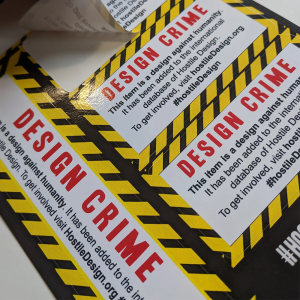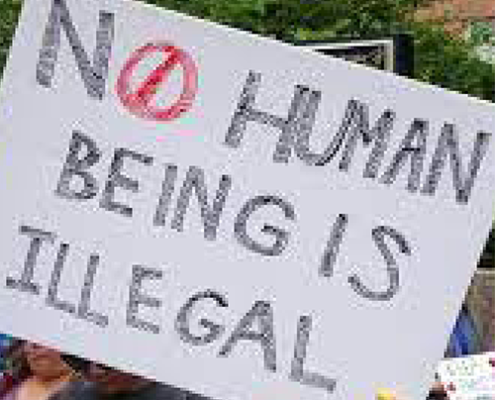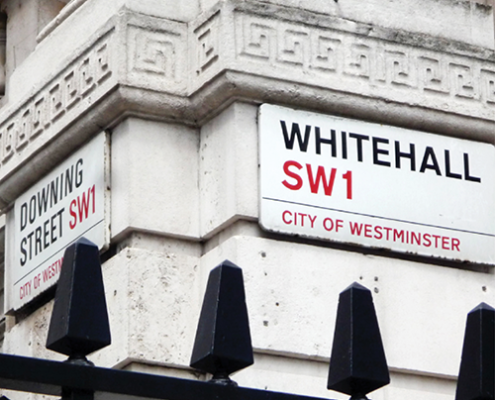Hostile Design | What Is It?
In time’s hurling and unfurling
On the night when comes thy call;
That compassion dew thy pillow
And absorb thy senses all
For thy victims,
Till death dark thee with his pall.”
Thomas Hardy
As a priest, I find the notion of hostile design not just inhumane and abhorrent; but a demonstratable manifestation of ‘everyday evil’. Those things that make life purposefully difficult for a specific already-marginalised group which the general public might not notice or, at worst, will encourage simply because of the effectiveness of horizontal hostility.
This a manifestation of how government, whether big or small, will get one group of the electorate to point at a disadvantaged group in the hope of improving life rather than look to the government to work to resolve the causes of, in this case, homelessness.
Hostile design, also known as defensive architecture or defensive design, refers to the intentional design of public spaces or objects to discourage certain behaviours or specific groups of people. It involves implementing measures that make areas uncomfortable, unwelcome, or even physically inaccessible to individuals engaging in undesirable activities, such as loitering, sleeping rough, skateboarding, or sitting for prolonged periods.
Hostile design strategies can take various forms, including:
- Anti-homeless measures: This includes the installation of spikes, ridges, or uncomfortable dividers on benches, ledges, or other public seating areas to deter homeless individuals from sleeping or resting there.
- Sloped benches or seating: The deliberate construction of seats with an uncomfortable slope or design that discourages extended sitting or lying down.
- Restrictive architecture: Designing public spaces with features that make it difficult or impossible for certain activities to take place, such as the installation of armrests or dividers on public benches to prevent lying down.
- Metal barriers: Placing metal railings, barriers, or protrusions on surfaces like window sills, planters, or ledges to prevent people from sitting or loitering in those areas.
- Harsh lighting or loud music: The use of bright lights or constant loud music in public spaces to deter individuals from congregating or staying in a particular area for an extended period.
- One-way benches: Designing benches with divided seats that only allow people to sit facing forward, preventing people from lying down or resting comfortably.
Critics argue that hostile design disproportionately targets vulnerable populations, such as homeless individuals, youth, or marginalized groups, effectively excluding them from public spaces and exacerbating social inequality. They argue that it is a way of treating the symptoms of social issues rather than addressing the underlying causes.
Conversely, proponents of hostile design argue that it helps maintain order and cleanliness in public spaces, enhances safety and security, and protects the rights and comfort of other individuals who use those spaces.
It’s worth noting that there is an ongoing debate surrounding the ethics and effectiveness of hostile design, and many cities and communities are reevaluating these design practices to create more inclusive and welcoming public spaces.
What Is Wrong With Hostile Design?
- Ethical concerns:
- Discrimination: Critics argue that hostile design disproportionately affects vulnerable populations, such as homeless individuals, youth, or marginalized groups. They view it as a form of discrimination and argue that it further marginalizes and excludes already disadvantaged people.
- Right to public spaces: Hostile design can be seen as infringing upon individuals’ right to access and enjoy public spaces freely. It restricts the use of public spaces and limits the activities that individuals can engage in, effectively shaping and controlling behaviour.
- Stigmatization: Hostile design can contribute to stigmatizing certain groups by sending a message that they are not welcome in public spaces. It can reinforce negative stereotypes and perpetuate social divisions.
- Effectiveness concerns:
- Temporary solutions: Critics argue that hostile design addresses the symptoms of social issues rather than tackling the root causes. It fails to address the underlying problems, such as homelessness, poverty, or lack of social support.
- Displacement: Some argue that hostile design merely displaces the issue from one location to another, pushing homeless individuals or unwanted activities into neighboring areas. It does not provide long-term solutions and can create a cycle of displacement and exclusion.
- Negative impact on community: Hostile design can create an unwelcoming and sterile urban environment. It erodes the sense of community and discourages social interaction, as people feel uncomfortable or unwelcome in public spaces.
- Alternatives and inclusive design:
- Design for all: Proponents of inclusive design argue for creating public spaces that accommodate the needs of all individuals, including vulnerable populations. They advocate for user-friendly design that promotes accessibility, inclusivity, and social integration.
- Social solutions: Critics of hostile design emphasize the importance of addressing social issues through comprehensive approaches, such as providing affordable housing, access to healthcare, supportive services, and community engagement programs.
- Participatory design: Engaging the community in the design process can lead to more effective solutions. By involving diverse stakeholders, including those directly affected by design decisions, more inclusive and context-sensitive solutions can be developed.
In recent years, there has been a growing movement to challenge hostile design and promote more inclusive and equitable urban spaces. Many cities and communities are reconsidering their design practices and exploring alternative approaches that prioritize human needs, inclusivity, and social well-being.
What Communities Could Be Like.
Here are some examples which Local Authorities can use to ensure an inclusive agenda for homeless people:
- Homeless shelters are designed with accessible entrances and pathways for individuals with mobility challenges, ensuring easy access for everyone.
- Restrooms in shelters are equipped with hygiene facilities and storage space for personal belongings.
- Multi-purpose spaces within shelters that can serve as safe storage areas for personal belongings during the day.
- Designated areas in shelters that prioritize the needs and comfort of individuals with pets or service animals.
- Well-lit pathways lead to shelters and public spaces to enhance safety and visibility at night.
- Outdoor seating areas near shelters with features like shade, benches, and water fountains to provide rest and respite.
- Shelters with flexible sleeping arrangements, such as individual cubicles or partitions, provide privacy and dignity.
- Community gardens or urban farming initiatives involve homeless individuals in growing food and fostering a sense of belonging.
- Outdoor exercise areas with basic workout equipment are accessible to homeless individuals looking to stay physically active.
- Public facilities, including libraries or community centres, offer access to computers and the Internet for job searches and communication.
- Transitional housing is designed with features like communal kitchens, laundry facilities, and shared living spaces to foster a sense of community and support.
- Designated areas in public spaces, such as parks or plazas, with secure lockers for homeless individuals to store their belongings.
- Collaborative design projects that involve homeless individuals in the planning and creation of public spaces, fostering a sense of ownership and empowerment.
- Public conveniences with 24/7 access ensure that homeless individuals have hygienic facilities at all times.
- Outdoor charging stations for electronic devices provide homeless individuals with access to communication and essential resources.
- Incorporating public art installations that promote empathy, awareness, and understanding of homelessness-related issues.
- Safe and well-maintained bicycle parking areas to accommodate homeless individuals who rely on bikes for transportation.
- Designing public transportation systems with affordable fares and discounted passes to facilitate access to essential services and employment opportunities.
- Coordinated efforts between businesses and shelters to create job opportunities and vocational training programs tailored to homeless individuals.
- Community outreach programs that involve homeless individuals in maintaining and beautifying public spaces instil a sense of pride and connection to the community.
- Public facilities equipped with laundry facilities or partnerships with launderettes provide access to clean clothing and personal hygiene.
- Mobile outreach units provide medical, mental health, and social services directly to homeless individuals in their locations.
- Designing public spaces with designated areas for food distribution and community meals, ensuring that homeless individuals have access to nutritious meals.
- Incorporating universal design principles in constructing affordable housing units, considering the needs of homeless individuals with disabilities or health conditions.
- Comprehensive social support programs address the root causes of homelessness, including affordable housing, job training, mental health services, and substance abuse treatment.
These inclusive design practices aim to create a more supportive and dignified environment for homeless individuals, providing them with essential resources, access to services, and opportunities for empowerment and community integration.
What Can You Do To Help?
Together we can shut down Hostile Design
Hostile designs are designs against humanity. They are made specifically to exclude, harm or otherwise hinder the freedom of a human being. Quite often they aim to remove a certain section of a community from a public space.
This site exists to provide a platform to raise awareness around hostile design, empower you to name and shame those involved in it and create a living archive of hostile design around the globe. Ultimately the idea is that through awareness we can dissolve prejudice, influence planners and city councils and create more inclusive welcoming public space for everyone.
Here are some other posts folks have read:
About Rev Lloyd Hobbard-Mitchell
Rev. Lloyd Hobbard-Mitchell, an Englishman deeply connected to Thailand, was ordained to the Sacred Priesthood on 28th May 2023.
In addition to his religious journey, he has worked as an online English teacher and pursued a career as an artist. He has also operated a tour desk business with his wife within international brand hotels.
Lloyd has extensive experience in the voluntary sector, specifically in addressing homelessness and social welfare.
He is a Fellow of the Royal Geographical Society and embraces opportunities to meet new people, see new places, explore cultural similarities, and celebrate differences.






